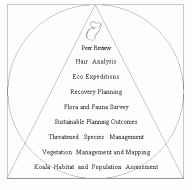![]()
* Australian Mammal Society Conference 2019
Copies of presentations given by Biolink staff at the 65th Annual Scientific Meeting of the Australian Mammal Society (2019).
Abstracts of the presentations are as follows;
Killing them softly with our song... negative outcomes arising from the management of disease in peri-urban koalas (Dr Steve Phillips)
Since its discovery in the mid-1970s, diseases collectively considered under the umbrella of Chlamydiosis have been perceived as a serious threat to the viability and conservation status of most free-ranging koala populations in eastern Australia. But if this is really true and notwithstanding other biotic considerations – why are koalas still relatively widespread across their remaining geographic range? Current solutions to the management of Chlamydiosis in free-ranging koala populations range from antibiotic therapies and the development of specialized vaccines, to the euthanasia of diseased animals, all of which are implemented and/or being undertaken in an attempt to improve the reproductive capacity and health of populations so affected. Using longitudinal hospital data collected over the last 20 – 30 years, we demonstrate ongoing koala population viability against a cyclical background of disease-mediated mortalities in a koala population on the far north coast of NSW, as well as the facilitation of near endangerment of a regionally significant population in south-east Queensland by poorly informed euthanasia practices. Moreover, there is little benefit in attempting to control disease if the causal factors that contribute to its prevalence / expression are not effectively managed in the first instance. It is time for a new song.
A bird in the hand... coming to grips with the concept and components of koala source populations (Dr Grant Brearley)
Small localised source populations are, in essence, the 'engine-rooms' that enable larger, regional koala populations to persist over time. Finding such source populations remains critical for effective landscape-scale koala conservation, but before such status can be conferred, we need to know what to look for. We demonstrate how historical koala records can be used to examine and quantify changes in the distribution and abundance of koalas over time frames of relevance to koala conservation, including concepts such as Generational Persistence which examines the data for records of koalas reoccurring in a localised area over generational time frames, thereby identifying the likely presence of local and regional source populations. Caution is advised however, as the precise location of a local and/or regional source population or hub may or may not be immediately apparent using records alone. Using data from the Port Stephens LGA, we further demonstrate how the absence of records can also be utilised to achieve the same result. Understanding changes at the local and regional scales and distributional patterns over time frames that are of relevance to koalas is elemental to effective longer-term management and recovery of the species.
Making tracks: new approaches to modelling dispersal pathways and koala habitat connectivity (Dr Amanda Lane)
Habitat connectivity is essential for maintaining the long-term health of koala populations and the loss of dispersal pathways is identified as a key threat in the NSW Koala Research Plan (2019 - 2028). Current approaches to sustaining koala habitat connectivity generally speak to a broad geographic perspective, informing large-scale landscape priorities, whereas objective information on enhancing connectivity outcomes at finer scales is scarce. We utilise new analytical approaches to identify locations that offer the most suitable dispersal pathway opportunities to connect areas of Preferred Koala Habitat at smaller scales in three locations across NSW, namely Campbelltown / Wollondilly, Port Stephens and Port Macquarie. The GIS-based GAP CLoSR (General Approach to Planning Connectivity at Local and Regional Scales) framework considers, amongst other things, the ecological needs and movement characteristics of koalas and the extent to which the landscape functions to impede and/or facilitate their movements, including considerations such as minimum habitat patch size and the greatest distance of open ground that can be crossed. Recommendations arising from analyses can be used to finalise road design and other development outcomes and inform the best ways to consolidate connectivity at specific locations in light of changing land-uses and encroaching urban and agricultural development.
Mitigating koala threats from the desk: a quantitative approach to identifying and monitoring vehicle-strike hotspots (Kirsty Wallis)
Vehicle-strike is a threat to koalas throughout most of the species' remaining range in eastern Australia and is a factor driving ongoing koala population decline in many areas. The total numbers of mortalities resulting from vehicle-strike is often under-reported, while black-spot identification remains largely anecdotal. Identification of discrete, manageable road segments which inform the need for and placement of mitigation measures can be both planned and cost-effective. This study demonstrates how koala vehicle-strike data can be analysed to create a standardised and repeatable approach to the initial assessment, correcting for under-reporting and informing ongoing monitoring of road-based koala mortalities. We used ArcGIS to intersect road segments with Euclidian clustered vehicle-strike records, further partitioned by koala-generation to highlight the discrete areas that generate the highest mortalities in an area. As demonstrated by case studies, vehicle-strike black spots can be readily identified and expressed in terms of numbers of koalas struck / km / generation. This approach can assist government road managers and councils to better direct their budgets to known high-ranking vehicle collision areas. Moreover, data enables effective long-term monitoring of the efficacy of vehicle-strike mitigation measures and consequently informs best practice mitigation measures on new roads with similar features.



